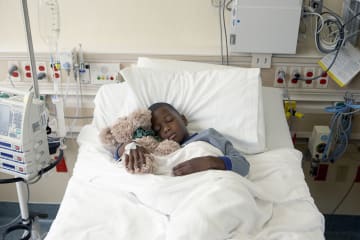Learning About Equipment in the Pediatric Intensive Care Unit (PICU)

What equipment is used in the PICU?
A PICU is full of special equipment to help care for your child and keep your child as safe and comfortable as possible. The PICU staff will answer your questions and tell you how these tools are helping your child.
Some machines will beep or display information all the time. Others have alarms on them for emergencies. Usually an alarm just means that something needs to be adjusted, and the care team may come in and check on it. Ask a member of the PICU staff if you are concerned about the information or alerts on any of the machines.
Breathing equipment
- A ventilator is a machine that breathes for a person who has trouble breathing. The tube is placed in the windpipe through the nose or mouth.
- A continuous positive airway pressure (CPAP) machine may be used when a ventilator isn't needed. It gently pushes oxygen or air into the lungs through a mask over the nose or mouth. Children can breathe on their own with this extra help.
- A nasal cannula is a device with two prongs. The prongs are placed in the nostrils when a child just needs more oxygen. The oxygen goes through the tubes and into the nostrils.
- Oxygen may also be given through a mask. Oxygen flows through a tube and into a mask that's placed over the nose and mouth.
- An oxygen tent or hood can also help your child or baby get enough oxygen.
- A tracheostomy or "trach" tube (say "trayk") is a breathing tube that goes straight into the windpipe. It's used when a person needs to be on a ventilator for a long time. It also helps remove mucus and fluid from the lungs. A surgeon will insert the trach tube.
Medicine, fluid, and nutrition
- An intravenous (I.V.) site gives access to a vein. It may be placed in the back of the hand. Or it may go in the foot, arm, leg, or scalp. One end of a tube is attached to the site. The other end may be attached to a medicine pump. It can also be used to take samples of blood for testing.
- A central vascular access device or central line is put through the skin into a vein and ends in a larger vein near the heart. It can stay in place longer than an I.V. It can deliver fluids or medicines quickly if needed. It can also deliver nutrition and can be used to monitor your child.
- A PICC line is a long, thin tube used to deliver medicines. It most often is put into the body in the arm and ends in a large vein in the chest. A PICC line is a type of central line.
- Medicine pumps deliver exactly the right amount of medicine at the right time. The medicine flows through an I.V. site or a central line. These pumps may beep a lot.
- Gastrostomy (G-tube) or nasogastric (NG-tube) feeding tubes deliver nutrients to a child who can't eat. A G-tube goes directly into the stomach. An NG-tube is put through the nose into the stomach. They can also remove excess fluids from the stomach and provide medicine.
Other equipment
- An inflatable cuff on the arm or leg takes blood pressure readings. It sends the data to a blood pressure monitor.
- Temperature probes keep track of the child's temperature.
- A heart monitor has a sensor that attaches to the chest to track the heart rate.
- A pulse oximeter is put on the earlobe or on the end of a toe or finger. For babies, it may be put on the palm or foot. It measures how much oxygen is in the blood.
- Extracorporeal membrane oxygenation (ECMO) is used for children who have very serious lung or heart problems. A special machine puts oxygen into the child's blood and takes carbon dioxide out of the blood.
- A Foley, or indwelling, catheter drains urine when a child can't use the toilet on their own.
- A dialysis machine helps adjust the level of fluids and waste products in the blood. This may be done if your child has kidney problems.
- Electrodes may be placed on your child's head to check electrical brain waves.
Current as of: October 24, 2024
